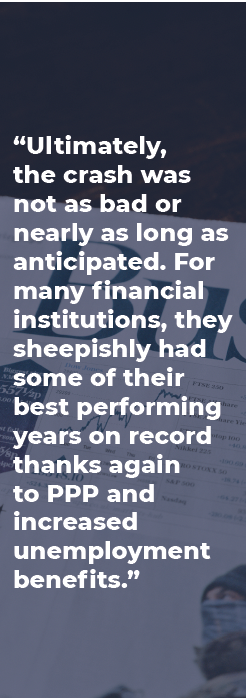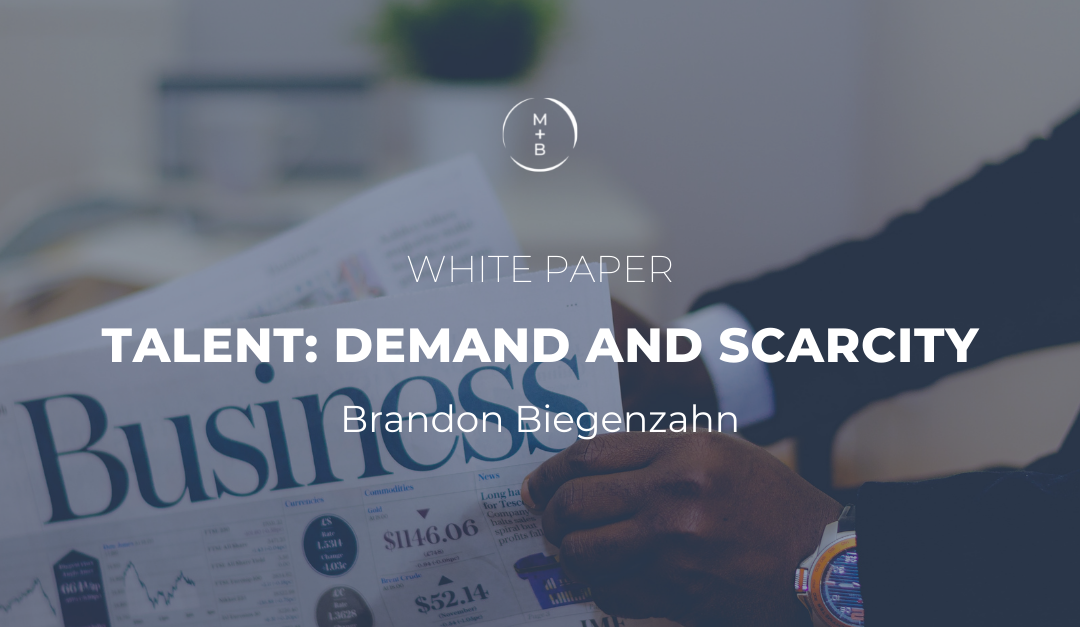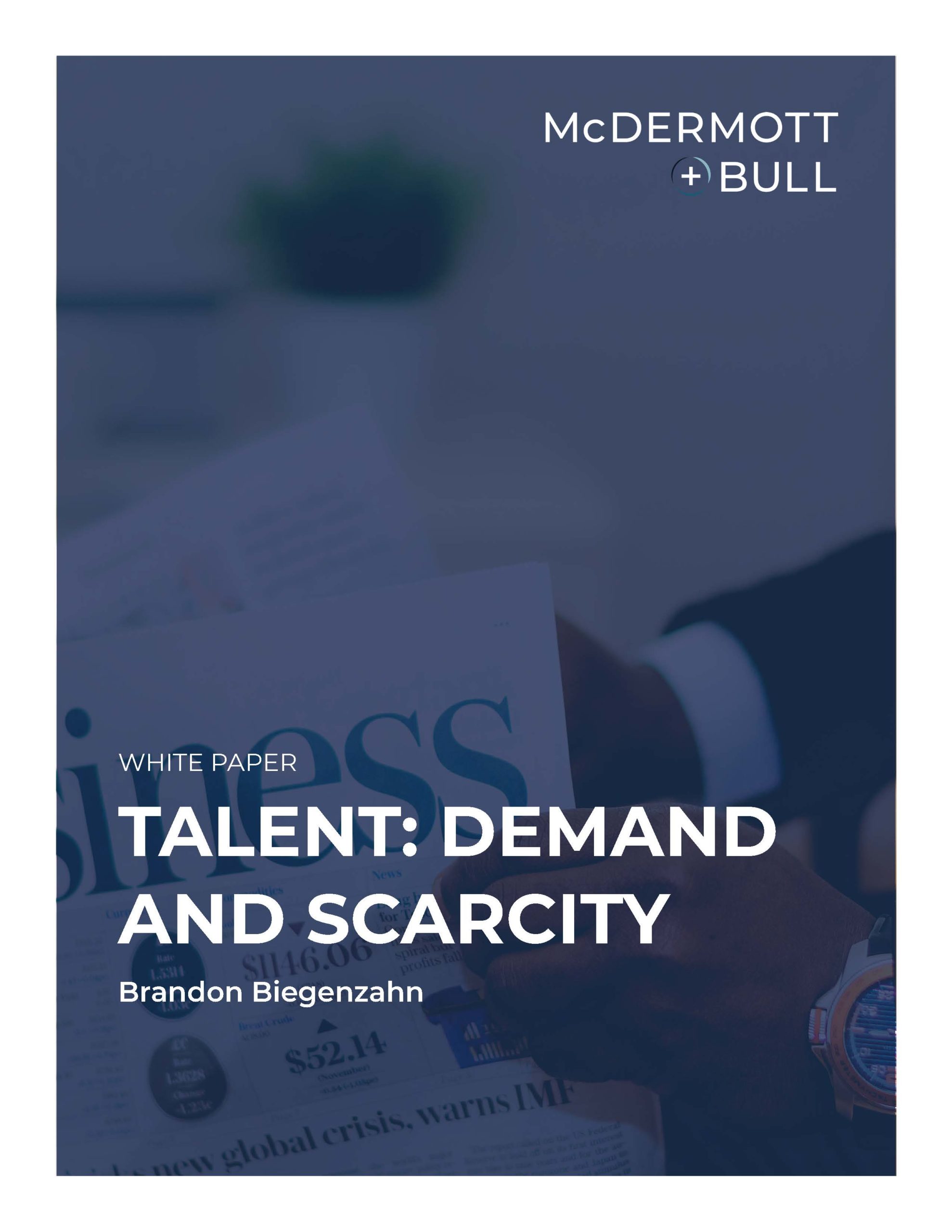The Demand for Talent
To state the obvious, the pandemic has brought about tremendous change across the global landscape. The most glaring impact in my world, brokering in executive level talent in financial services, has been the massive demand for talent, and the scarcity of that talent.
Across nearly all industries, other than retail and hospitality, the demand for talent at all levels of the organizational chart is at a record high. We are seeing this at McDermott + Bull, and a quick glance at the earnings reports of our publicly traded executive search competitors reveals the same. We are also hearing similar reports from the recruiting firms that play below the executive level. As an aside, it is striking that in the financial services space, demand for executive level talent did not wane in 2020. Instead, it surged. I believe that the Paycheck Protection Program (PPP) and the Unemployment Stimulus drove much of this, as commercial and consumer financial services firms got shots in the arm (pun intended) from the government (pun not intended, and neither is any specific political leaning, just a factual statement regarding fiscal policy.) With Q4 upon us, the majority of other industries have caught up in their need to build their executive ranks, and it is impacting us all.
What is driving the demand?
As the grip of the pandemic really took hold in Q3 of 2020 across all industries, companies were preparing for a long and harsh recession. In response, many companies laid people off, and put a pause on most hiring. To compound the issue, with hiring on hold, internal recruiting teams made up a large segment of those laid off. These dynamics put companies behind their hiring goals, while also dismantling the hiring machine created to meet those goals.
Ultimately, the crash was not as bad or nearly as long as anticipated. For many financial institutions, they sheepishly had some of their best performing years on record thanks again to PPP and increased unemployment benefits. Over the last three quarters, we have been experiencing a bull market — U.S. private equity deal making through Q3 2021 has already eclipsed 2019’s annual record for deal value at more than $787 billion; venture capital’s strength continues to support the country’s economic recovery as exit value reached $187 billion, pushing the total for 2021 past $582 billion — more than twice 2020’s record figure; and the major stock markets have hit records as well.

Furthermore, according to CareerArc’s 2021 Future of Recruiting Study, which was completed at the beginning of 2021, 76% of companies anticipated the 2021 hiring demand would exceed pre-pandemic levels. We’re now seeing this play out. All of the backfills where companies went without during COVID are now back in play. Those same companies are putting their paused expansion plans back into motion, and all of the strategic hires that weren’t approved due to unpredictable revenue forecasts came back from February through May. Usually, those are spaced out throughout the year, but in 2021, they have come back all at once.
Finally, in what is being referred to as the Great Resignation, many workers are either changing employment or leaving the workforce entirely. A survey conducted in June by Monster showed that 95% of respondents are considering a job change.
The Talent Scarcity Situation
In the U.S., where recovery in the labor market has been impressive, record job vacancies are being reported. According to the U.S. Bureau of Labor Statistics, job openings in the world’s largest economy sat at 10.4 million in September (the latest available figures at the time of publication). This number is well above the number of hires in September, at about 6.5 million. The incongruity indicates a huge mismatch in the American labor market right now.
To provide a more global context, in Europe, the Middle East, and Africa (EMEA), signs of a strengthening economy and labor market are also growing. Eurozone business activity recently grew by its fastest rate in 15 years. In the U.K., businesses face the worst labor shortage since 1997, and a combination of higher demand and border restrictions has led to the fastest drop in talent availability on record.
The most vexing aspect of today’s market is that demand for labor is rising, while millions remain unemployed around the world. In Organization for Economic Co-operation and Development (OECD) countries — including the likes of the U.S., U.K., most of Western Europe, Japan, and Korea — there is still a deficit of eight million jobs, as well as 14 million more people who are voluntarily staying out of the labor market compared to the end of 2019. Unemployment figures also fail to reflect underemployment problems in places like Australia, where a growing number of people can’t get enough work to meet their income needs. Additionally, we know that the pandemic forced more women out of the workforce than men due to factors such as family obligations.
A number of factors have played into the scarcity within the talent market. The movement dubbed the Great Resignation is one of them, and it appears to have three main drivers:

1. Retirement

2. The existential crisis

3. Forced resignation
Another contributing factor is the shift to a candidate’s market, where we see a combination of high demand for talent, scarcity of that talent, and increasing flexibility in working arrangements.
⇒ The pandemic has brought about an entirely new way of conducting business, with many companies operating with a “distributed workforce” model (put another way, work from anywhere). We have found that remote work, defined as working outside the office the majority of the time, is now, and perhaps has always been, a massive currency for people.
⇒ We are seeing a snowball effect that is driving the candidate’s market. Meaning, if a company doesn’t offer remote work, they are forced to increase pay. With such a demand for talent, companies that are willing to offer remote work are also matching increased compensation. Furthermore, with so few viable candidates, companies are forced to look beyond industry lines, thus causing cross-industry norms to be adopted when they historically were not.
With this confluence of events, people now have the freedom to choose a path that was not available to them just two years ago. In summary, the perfect storm caused the current talent crisis:
-
- Layoffs due to COVID-19;
- pent-up demand of projects that were delayed during the COVID-19 pandemic; and
- demand associated with a V-shaped recovery in an expanding U.S. economy.
How long will it last?
Though it may prove impossible to forecast, I believe the demand for talent will be with us for the next five years. Pandemic or not, boomers are going to continue to retire. Additionally, the easing of formal working arrangements is our new normal – I believe it will not change. My two preschool-aged children will likely not have to factor in a commute when they look for their first jobs, or perhaps any of their jobs. Bizarre and hard to believe, but that time is here. As big companies across industries shut down their management training programs, those early in their careers will receive training in specialized verticals, but not across the organization. Thus, leaders who truly understand the totality of a business will be fewer and farther between. I forecast that demand will increase, perhaps exponentially. Ultimately though, I hope we are left with a new set of leaders who have worked across industries and thus bring diversity of thought to the boardroom. However, I believe that to be a generation from now.

How to combat it?
While what has been discussed herein may seem overwhelming, I don’t believe it is as dire as it may appear. While the prospect of greener pastures sounds interesting, many people are genuinely happy right where they are. So, keep them that way. Let them know they are valued and keep them busy.

Compensation

Be intentional about interpersonal relationships

Flexible work arrangements
This is hard for me to admit, as I’m one of the few who likes a suit and tie and the formality of my workday, but flexibility reigns. If you want people in the office because you like having people around, it’s the wrong reason. Look at productivity. If it’s high when working remote, then keep it that way or at least offer it. To make this easier to stomach, clients of ours who offer fully remote work arrangements are able to attract talent at a lower price because the ability to work remote is a currency in and of itself.
Change is always difficult, but it is frequently accompanied by positive progress. With respect to talent attraction and retention, here’s to adaptation and advancement.
About the Author
Brandon Biegenzahn
President
biegenzahn@mbexec.com
Brandon Biegenzahn is the President of McDermott + Bull and the chair of the firm’s Financial Services Practice Group. Brandon is a corporate attorney who practiced with Sheppard, Mullin, Richter & Hampton, and Buchalter Nemer in their corporate finance departments. Brandon received his Bachelor of Arts from the University of Southern California and his Juris Doctorate from Penn State.



